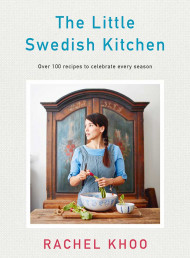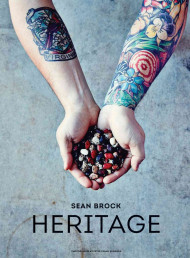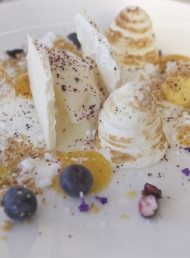Cook the Books - Scandinavian Baking Part Two

David Parker tests out Trine Hahnemann's latest cookbook once more, with a classic Danish recipe - Sønderjyske Rye Bread.
Cook the Books is a new online series in which amateur baker David Parker reviews recipe books from a practical perspective. This is the second recipe he's created from Trine Hahnemann's Scandinavian Baking - Loving Baking at Home. To see how he got on with her Raspberry Eclair recipe, and for the review of the cookbook we published in Dish magazine, click here.
David Bakes: Sønderjyske Rye Bread
Trine Hahnemann goes on about rye bread a lot in this book, she claims it's almost the only bread she eats!
Before I go on, a word of warning. This is a beautiful book, and if you happen to find yourself reading it in a place where other people are present, you will feel the sudden loss of it being pulled variously from your hands by curious friends. Take extra caution around Scandinavians.
I had a close encounter with a group of them at a bar, with each nostaligcally poring over it to find which local delights had made the cut. One Danish man proudly held up the recipe for Sønderjyske Rye Bread and proclaimed “This is a Danish recipe! You must make this!” His eyes welled up on seeing a special dish from home printed in English.
I've had rye bread before and didn't think it was that special so I thought I'd see what the fuss with Sønderjyske Rye Bread was about.
Rye flour is not as easy to find in New Zealand supermarkets as I imagine it is in Europe, but I managed to get my hands on some at a local speciality foodstore (Harvest Wholefoods in Grey Lynn). Conveniently it was both stoneground and organic, as specified by the recipe book.
Making any sourdough bread starter is a long process - a rye variety takes even longer. I put buttermilk and rye four in a sealed container in the fridge for three days to cultivate yeast. Bubbles formed by the third day but they were tiny. I was surprised how pungent the smell was - a lot stronger than other starter recipes I've used for sourdough breads.
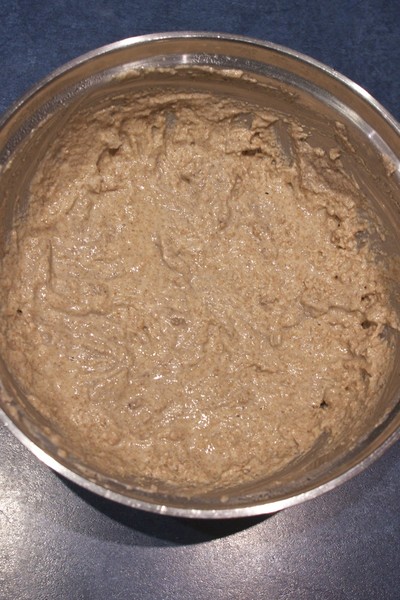
On the third day, I took out the starter and fed it with water, rye flour and salt and put it back in the fridge for another night's fermenting.
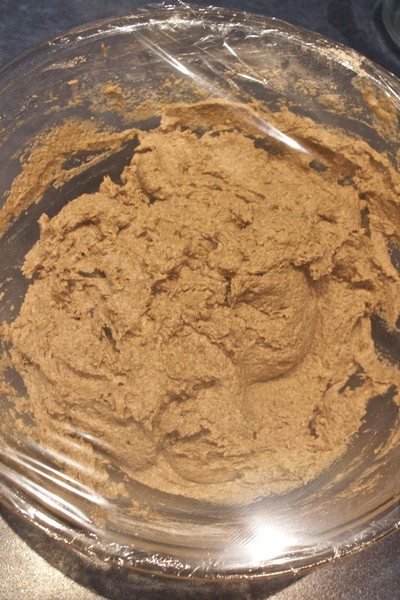
I have a confession to make. I don't intend on making Rye Bread again anytime soon. I know. I am a terrible person and I imagine Trine would be very upset with me. Thus, whilst the recipe specifies that you should remove 400 grams of the starter to establish the base for your next, I simply fed it to the septic tank. I hope the yeasts get on okay in there.
The remaining bowl of pungent yeast formed the base of my bread. I've kneaded my fair share of bread dough before and I am pretty adept at taming a wet sticky dough through kneeding without the use of additional flour. But I've never worked with a 100 percent rye flour dough. It was VERY sticky, I wish I had a stand mixer for jobs like this.
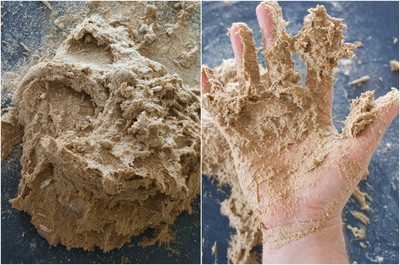
I worked the dough for about 20 minutes (with a few one minute breaks) but it didn't really seem to progress, I think it got a little less sticky but that's not saying much. Eventually, I hoped that this was what constituted a fully kneaded rye dough and took the plunge.
With a dusting of flour to stop my hands sticking to the dough, I could easily shape it into a log which I covered with a teatowel and left to... well I wasn't sure - as according to the recipe it wouldn't visibly rise - just form cracks. So I waited for it to crack? I hoped I was doing the right thing.
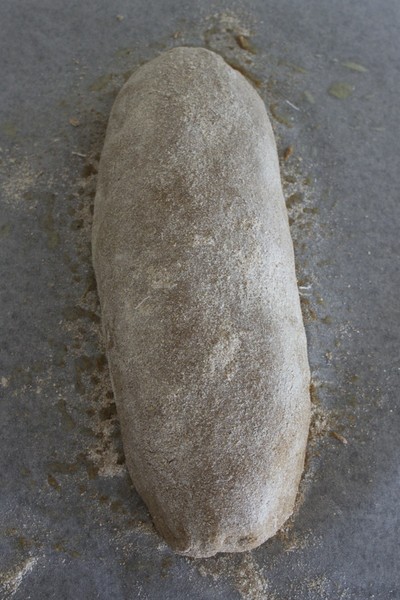
After two hours I took a little peek under the teatowel. “CRACKS! It's cracked!” I couldn't control myself from yelling inside the airing cupboard. I was so relieved to see the cracks, I was on the right path but they were very small so I decided to leave it in there for the full three hours.
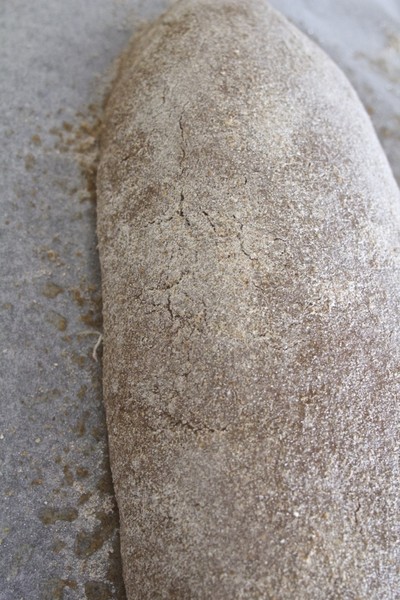
Then into the oven it went.
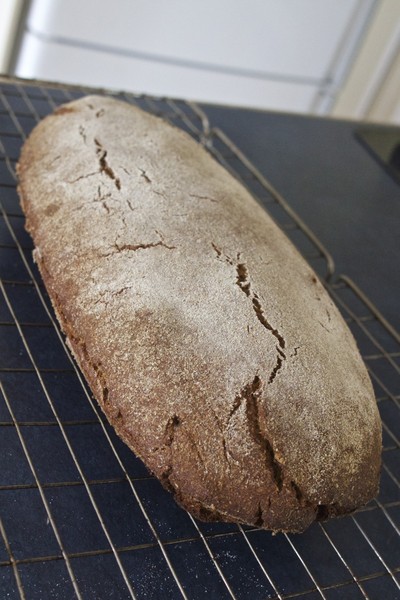
The flavour was very intense, much as the smell had been, it was very sour with a malty undertone. It was very earthy.

The bread was a little heavy for my liking but with an amazing crust and very smooth centre. Whilst I am not running out to the shops to stock up on rye flour, I am deeply regretting my decision to pour the rest of the starter down the sink, as I did enjoy the Sønderjyske Rye Bread for a bit of a change. As with other sourdough starters, they're enriched with frequent use, so if rye is up your alley, keep it around!
The Book Cooked
Level of expertise required: Some of the techniques here might be a little advanced for the beginner, and time consuming, but there are simpler recipes in the mix that are more accessible.
How many trips to the supermarket needed: 7... I spent a lot of time looking for fresh yeast to no avail, and I had to find specialty flours, there tends to be one special thing per recipe that you might not find at your everyday supermarket.
Average cost of recipes? The recipes I chose weren't cheap, but most of the others you should be able to afford on a reasonable budget. This isn't student food, but you won't be breaking the bank.
How closely did the dishes resemble those in the book? 8/10 Very Instagram-able
Ease of reading: 7/10. Sorry was I supposed to be reading it? I was looking at the BEAUTIFUL photos. But actually it was pretty good. The choux pastry was a little difficult to understand but no other major difficulties.
Pretty on the coffee table or destined to be battered and used again and again? Buy two copies - one for the coffee table and one to be grabbed with dough hands. Or in case those pesky Scandinavians walk off with your book...
latest issue:
Issue #120
As the days become shorter, and the nights cooler, the latest issue is perfectly timed to deliver delicious autumn dishes. From recipes using fresh seasonal produce such as feijoas and apples, to spectacular soothing soups and super-quick after-work meals in our Food Fast section, we’ve got you covered. With Easter on the horizon, we feature recipes that will see you through breakfast, lunch and dinner over a leisurely weekend holiday, and whip up chocolatey baking treats sure to please. We round up delicious dinners for two and showcase a hot new Korean cookbook before heading south to Dunedin to check out all that’s new in food and dining.The latest issue of dish is on sale NOW at all good bookstores and supermarkets – don’t miss it!

